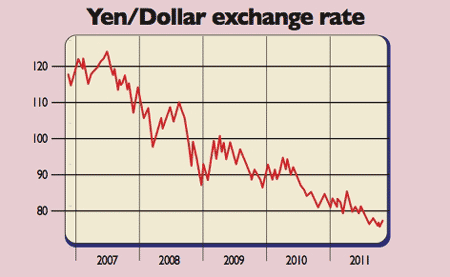
“Monday’s currency intervention from Japan’s Ministry of Finance was a classic one-two punch,” says the FT’s Lex column. First, the authorities sold around ¥3trn in an effort to weaken the currency. Then finance minister Jun Azumi announced that much more selling would follow if the speculative bets on a rising yen continued to build. It worked in the short term: the exchange rate was down almost 5% a few hours later. The question is whether this time it will stay weaker.
Many analysts are doubtful. “Recent Japanese interventions have not been successful in delivering sustained yen weakness,” says Danske Bank. The chart below demonstrates this only too well. This is the fourth time that Japan has staged a currency intervention in just over a year, yet the yen remains near record highs. The problem is that “Japan is not particularly good at this game”, says The Economist’s Free Exchange blog. “Large, one-off interventions against a backdrop of sustained deflation are unlikely to be effective; markets know the yen will be going back up again in no time.”
Policymakers will need to be willing to make repeated interventions, but “Bank of Japan Governor Shirakawa’s remark that the yen is not particularly strong on a trade-weighted basis suggests little real enthusiasm at the central bank”, says Capital Economics. “What’s more, repeated intervention in the coming days would not go down well at the G20.” With investors looking for a safe haven from the European crisis – and the Swiss franc now out of bounds after the Swiss National Bank’s far more decisive move to cap its currency – the yen could still strengthen significantly, perhaps to 60 yen to the dollar by 2013.
This lack of resolution is unfortunate, because serious intervention could be very good for Japan, says Free Exchange. “If the Bank of Japan were to make a concerted effort to print yen… then deflation might finally be vanquished.” Other governments might not be happy about the weaker yen and what it would do for trade competitiveness. But they could choose to weaken their currencies – which would ultimately mean no gains in competitiveness, but widespread monetary easing and, effectively, global stimulus. However, there is a risk they would respond by increasing trade barriers instead, which would be less helpful.